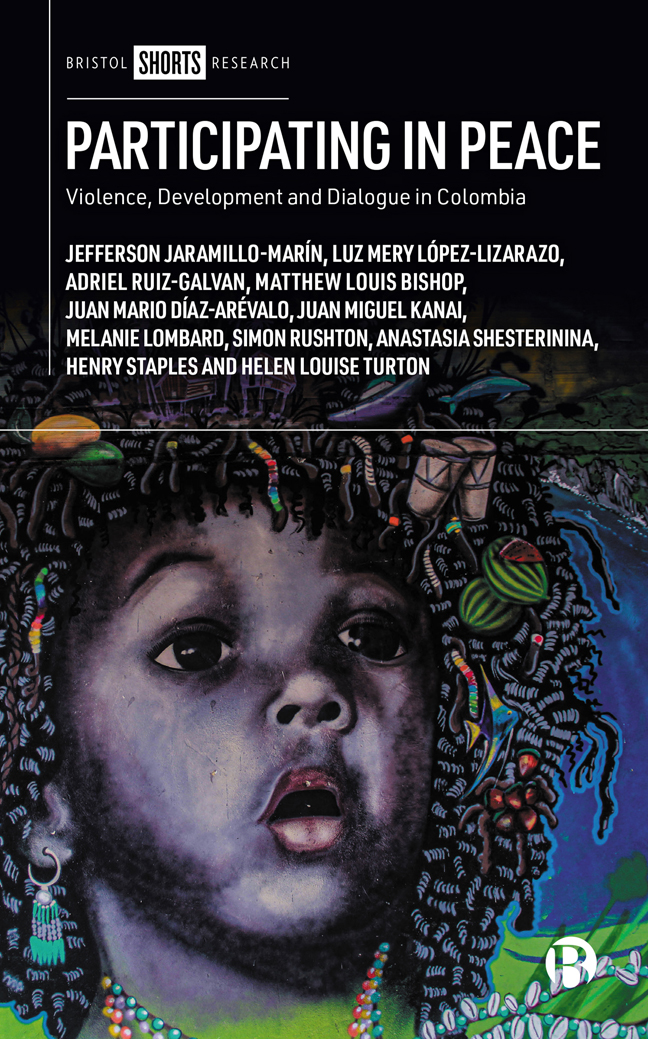Book contents
- Frontmatter
- Contents
- List of Maps and Tables
- List of Abbreviations
- Notes on the Authors
- Acknowledgements
- Note on the Cover Image
- Introduction
- One Peace through Participation: The Colombian Experience
- Two Participation through Dialogue: Co-Producing Peace and Research
- Three Protecting Catatumbo: Dialogue as Conflict-Sensitive Environmentalism
- Four Transforming Buenaventura: Dialogue for Municipal Peacebuilding
- Conclusion
- References
- Index
One - Peace through Participation: The Colombian Experience
Published online by Cambridge University Press: 24 January 2024
- Frontmatter
- Contents
- List of Maps and Tables
- List of Abbreviations
- Notes on the Authors
- Acknowledgements
- Note on the Cover Image
- Introduction
- One Peace through Participation: The Colombian Experience
- Two Participation through Dialogue: Co-Producing Peace and Research
- Three Protecting Catatumbo: Dialogue as Conflict-Sensitive Environmentalism
- Four Transforming Buenaventura: Dialogue for Municipal Peacebuilding
- Conclusion
- References
- Index
Summary
The 2016 Colombian peace agreement was lauded internationally as innovative, multi-layered and comprehensive. It went far beyond a simple commitment to lay down arms, incorporating further provisions on how to deal with various thorny legacies of the conflict, and also new challenges that would arise in response to its implementation. These included issues such as reparations for victims and the reintegration of demobilized FARC combatants, including guarantees for their political participation. Most ambitiously, the agreement sought to provide for the future economic growth of the predominantly rural areas that had been most heavily impacted by the conflict, often among the poorest in the country. In doing so, it incorporated much of the learning from previous peace processes (both those perceived as successful and those less so) that took place around the world in the post-Cold War era, while building upon multiple peacebuilding experiences and traditions developed in Colombia itself over the preceding decades. This unquestionably ambitious project of a participatory peace and geographically targeted development was, nevertheless, criticized widely from within Colombia. In the areas that were ostensibly intended to benefit from it, various social actors pointed to an implementation process that failed to address asymmetric power relations and, above all, the economic injustices that fuelled the armed conflict in the first place.
The discussion in this chapter situates the emergence of new forms of community-led participatory peacebuilding in relation to shortcomings in the peace process. Specifically, the chapter's goal is to contextualize the origins of the diálogos socio-territoriales (DSTs) discussed in Chapter Two and explored empirically in Chapters Three and Four. Particularly notable in the Colombian peace process was the government's use of social dialogue as a form of state-sponsored participatory peacebuilding, which in turn built upon previous civil society-led experiments with peace. The ambitious peace programme aspired to produce peaceful and prosperous futures for conflict-affected areas while involving the entirety of Colombian society in the process. However, it was also rather top-down in its initial composition, and various state–society interactions occurred during both the negotiation and implementation phases, which saw its very constitution and purpose becoming a site of conflict and contestation.
- Type
- Chapter
- Information
- Participating in PeaceViolence, Development and Dialogue in Colombia, pp. 11 - 35Publisher: Bristol University PressPrint publication year: 2023

